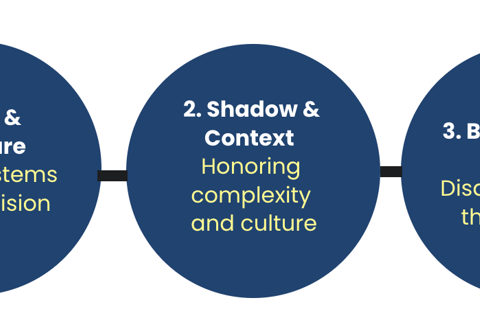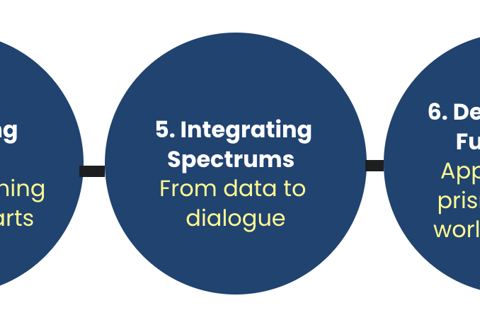Our Approach: The Prism Dialect
What is the Prism Dialect?
The Prism Dialect is both a methodology and a mindset—a tool Prism Impact uses to explore complexity with clarity. Just as light splits into color when passed through a prism, we believe organizations, teams, and systems contain multitudes—perspectives, data, tensions, emotions. Our approach helps disaggregate these layers and reorganize them into actionable insight.
Why the Prism?
Because strategy isn’t black or white—it’s a spectrum. This framework unfolds across six steps: from observing structures to designing in full color. It blends systems thinking with lived experience, using refractive logic to surface nuance and truth. What emerges is a fuller picture, where insight isn’t imposed, but revealed.
Does PRISM stand for anything?
Yes—PRISMS has taken shape in other contexts. It’s been used in public health implementation models and psychosocial screening tools. Our work builds on that legacy—infusing the metaphor with strategic, systems-based design:
Position • Resonance • Interpretation • Structure • Mobilization • Sustainment —six phases that mirror our six-step dialectical process. It's not just a name; it's a method for refracting complexity into clarity. Learn more about PRISMS in our Prism Blog.


The Six Steps of our Prism Dialect i.e., the "Refractive Method"






"Life is like a prism. What you see depends on how you turn the glass." — Jonathan Kellerman

What is the Prism Dialect?
The Prism Dialect is both a methodology and a mindset—a tool Prism Impact uses to explore complexity with clarity. Just as light splits into color when passed through a prism, we believe organizations, teams, and systems contain multitudes—perspectives, data, tensions, emotions. Our approach helps disaggregate these layers and reorganize them into actionable insight.
Why the Prism?
Because strategy isn’t black or white—it’s a spectrum. This framework unfolds across six steps: from observing structures to designing in full color. It blends systems thinking with lived experience, using refractive logic to surface nuance and truth. What emerges is a fuller picture, where insight isn’t imposed, but revealed.
Does PRISM stand for anything?
Yes—PRISMS has taken shape in other contexts. It’s been used in public health implementation models and psychosocial screening tools. Our work builds on that legacy—infusing the metaphor with strategic, systems-based design:
Position • Resonance • Interpretation • Structure • Mobilization • Sustainment —six phases that mirror our six-step dialectical process. It's not just a name; it's a method for refracting complexity into clarity. Learn more about PRISMS in our Prism Blog.
1. Light & Structure Seeing systems with precision
2. Shadow & Context Honoring complexity and culture
3. Breaking the Beam Disaggregating the problem
4. Refracting Insight Making meaning from the parts
5. Integrating Spectrums From data to dialogue
6. Designing in Full Color Applying the prism to real-world strategy
The Six Steps of our Prism Dialect i.e., the "Refractive Method"
"Life is like a prism. What you see depends on how you turn the glass." — Jonathan Kellerman


1. Light & Structure – Seeing systems with precision
We start with the visible. The structures, frameworks, and forms that define your ecosystem. Through strategic analysis and systems thinking, we illuminate the machinery of the moment—what holds power, where energy flows, and what forces shape your outcomes. This is the Newtonian angle: pattern recognition, mapping, measurement. Learn more.


2. Shadow & Context – Honoring complexity and culture
The prism does not function in a vacuum—and neither do programs. We must understand not just structures but surroundings. Shadow reveals complexity: community dynamics, cultural meaning, trauma, resistance. This is where objectivity meets experience. Our methodology embraces both what is measurable and what is felt. Learn more.


3. Breaking the Beam – Disaggregating the problem
We call it breaking the beam. It’s the moment where you stop looking at the whole and start studying the spectrum. What are the real levers of change? What is signal, and what is noise? This is where we disaggregate—intelligently, humbly—and start to reveal the moving pieces. Learn more.


4. Refracting Insight – Making meaning from the parts
Breaking apart is only half the story. Once the beam is split, we begin to notice patterns—relationships between parts, unexpected alignments, colors hidden in plain sight. This is the act of refracting insight: turning raw data, stories, and disassembled truths into usable clarity. Learn more.


5. Integrating Spectrums – From data to dialogue
Prism thinking isn’t just for insight—it’s for alignment. Once the spectrum is understood, we bring the pieces back together through collaborative interpretation. We build shared language, translate findings across teams, and activate people around clear, co-owned meaning. This is integration: insight becomes strategy. Learn more.


6. Designing in Full Color – Applying the prism to real-world strategy
To design in full color means to build with full spectrum awareness. It means launching initiatives that account for nuance, context, and systems constraints without losing integrity. Prism strategy is pragmatic without becoming mechanical. It is visionary without becoming vague. Learn more.




